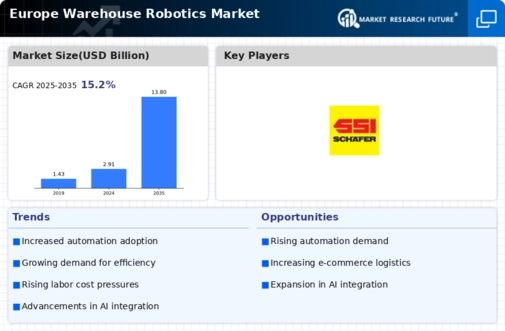Rising E-commerce Demand
The surge in e-commerce activities across Europe is a pivotal driver for the Europe Warehouse Robotics Market. As online shopping continues to gain traction, warehouses are increasingly tasked with managing higher volumes of inventory and order fulfillment. This trend necessitates the adoption of advanced robotic solutions to enhance operational efficiency and speed. According to recent data, the e-commerce sector in Europe is projected to grow at a compound annual growth rate of over 10% in the coming years. Consequently, warehouses are compelled to invest in robotics to streamline processes, reduce labor costs, and improve accuracy in order processing. The integration of robotics not only addresses the challenges posed by increased demand but also positions companies to remain competitive in a rapidly evolving market.
Government Initiatives and Funding
Government initiatives aimed at promoting automation and technological innovation are playing a crucial role in the growth of the Europe Warehouse Robotics Market. Various European governments are implementing policies and providing funding to support the adoption of advanced technologies in logistics and warehousing. These initiatives often focus on enhancing competitiveness and productivity within the sector. For instance, grants and subsidies for companies investing in robotics can significantly reduce the financial burden associated with such transitions. Additionally, government-backed research and development programs are fostering innovation in robotics, leading to the creation of more efficient and effective solutions. As these initiatives gain momentum, they are likely to stimulate further investment in warehouse robotics, driving market growth.
Technological Advancements in Robotics
Technological advancements are significantly shaping the Europe Warehouse Robotics Market. Innovations in robotics, such as improved sensors, machine learning algorithms, and enhanced navigation systems, are enabling more sophisticated and efficient warehouse operations. These advancements allow robots to perform complex tasks, such as picking and sorting, with greater accuracy and speed. The market is witnessing a shift towards collaborative robots, or cobots, which can work alongside human workers, enhancing productivity without compromising safety. As technology continues to evolve, the capabilities of warehouse robotics are expected to expand, further driving adoption rates. The integration of these advanced technologies is likely to result in a more streamlined and efficient supply chain, ultimately benefiting businesses across various sectors.
Labor Shortages and Workforce Challenges
Labor shortages in Europe are becoming increasingly pronounced, particularly in the logistics and warehousing sectors. This situation is driving the Europe Warehouse Robotics Market as companies seek to mitigate the impact of insufficient human resources. The aging workforce, coupled with the challenges of attracting younger talent, has led to a pressing need for automation solutions. Robotics can effectively fill gaps in labor availability, ensuring that operations continue smoothly without significant disruptions. Furthermore, the implementation of robotic systems can enhance productivity, allowing existing staff to focus on more complex tasks. As a result, the demand for warehouse robotics is likely to rise, as businesses strive to maintain operational efficiency amidst workforce challenges.
Increased Focus on Supply Chain Resilience
The emphasis on supply chain resilience has become a critical driver for the Europe Warehouse Robotics Market. Recent disruptions in global supply chains have highlighted the need for businesses to adopt more flexible and responsive logistics solutions. Robotics can enhance supply chain resilience by enabling faster response times, improved inventory management, and greater adaptability to changing market conditions. Companies are increasingly recognizing that investing in warehouse robotics can provide a competitive edge by ensuring continuity of operations during unforeseen disruptions. As organizations strive to build more robust supply chains, the demand for advanced robotic solutions is expected to rise, further propelling the growth of the warehouse robotics market in Europe.

















Leave a Comment